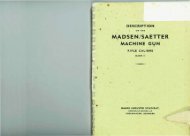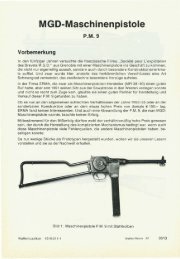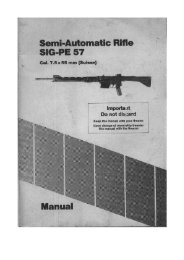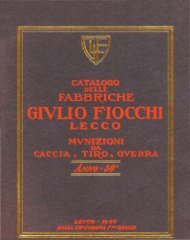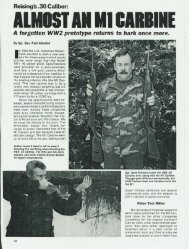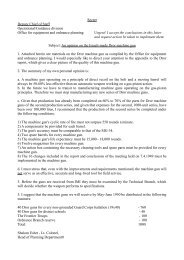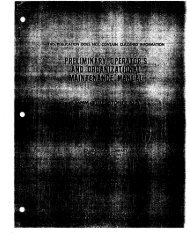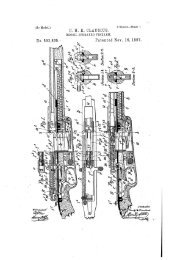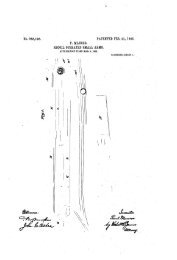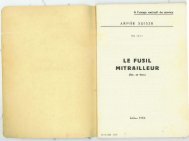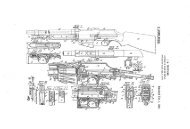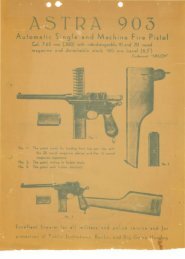Ross Rifle 1907 Manual.pdf - Replica Plans and Blueprints
Ross Rifle 1907 Manual.pdf - Replica Plans and Blueprints
Ross Rifle 1907 Manual.pdf - Replica Plans and Blueprints
Create successful ePaper yourself
Turn your PDF publications into a flip-book with our unique Google optimized e-Paper software.
10<br />
5. The retainer should be inserted with its milled edge outwards <strong>and</strong><br />
care must be taken that the nib on the retainer is carried over the shoulder<br />
in the bolt <strong>and</strong> down into its slot.<br />
6. It will be found advantageous to press down on the firing pin nut<br />
with the thumb of the right h<strong>and</strong> in order to lessen the friction when<br />
pressing the safety catch to the left to put it "on."<br />
KAllillS OF THE PARTS OF ROSS RIFLE, MARK II.<br />
B<strong>and</strong>, front.<br />
B<strong>and</strong>, rear.<br />
Barrel.<br />
Holt.<br />
Base sight, rear.<br />
Catch, safety.<br />
Clamps, slide, sight (2).<br />
Collar, windgauge.<br />
Cover. dust.<br />
Cut-off.<br />
E jector.<br />
Extractor.<br />
Guard, h<strong>and</strong>, front.<br />
Guard, h<strong>and</strong>, rear.<br />
Guard, trigger.<br />
Hood, sight, front.<br />
Knob catch, safety.<br />
Leaf, sight, rear.<br />
Lifter.<br />
L ink, strap, rear.<br />
Link, strap.<br />
Magazine.<br />
)!ut, clamp, stock.<br />
rut, bearing, lifter.<br />
Pawl.<br />
Piece, cocking.<br />
Piece, finger, lifter.<br />
Pin, base, sight, rear.<br />
Pin, axis, sight.<br />
Pin, cam.<br />
Pin, ejector.<br />
Pin, link strap (2).<br />
Pin, sear.<br />
Pin, firing.<br />
Pin, sleeve, sight, front.<br />
Pin, slide, sight (2).<br />
Pin, trigger.<br />
Plate, butt.<br />
Platform.<br />
Plunger, catch, safety.<br />
Plunger, piece, cocking.<br />
Receiver.<br />
Retainer, spring, main.<br />
Rivets, finger (2).<br />
Rivets, guard, h<strong>and</strong>, rear (2).<br />
Rivets, platform (2).<br />
Screws, b<strong>and</strong> (2).<br />
Screw, bearing, lifter.<br />
Screw, clamp, sight, front.<br />
Screw, clamp, stock.<br />
Screws, front, receiver (2).<br />
Screws, hood, sight ( 4).<br />
Screw, locking, barrel.<br />
Screw, link, strap.<br />
Screws, magazine (2).<br />
Screws, plate, butt (2).<br />
Screw, rear, receiver.<br />
Screw, windgauge.<br />
Sear.<br />
Sight, front.<br />
Sleeve, bolt.<br />
Sleeve, sight, front.<br />
Slide, index, right.<br />
Slide, index, left.<br />
Slide, sight.<br />
Spring, clamp, slide, sight.<br />
Spring, cut-off.<br />
Spring, plunger, catch, safety.<br />
Spring, ejector.<br />
Spring, guard, h<strong>and</strong>, rear.<br />
Spring, leaf, sight.<br />
Spring, lifter.<br />
Spring, main.<br />
Spring, pawl.<br />
Spring, sear.<br />
Spring, stop bolt.<br />
Spring, trap, butt.<br />
Stock.<br />
Stud, link, strap.<br />
Stop, bolt.<br />
Swivel piling.<br />
Thimble, micrometer.<br />
Trigger.<br />
Trap butt.<br />
Washer, pin firing.<br />
Washer, stock.<br />
'\Vindgauge.<br />
DESCRIPTION OF ROSS RIFLE, MARK II.<br />
BarreL-The barrel screws into the receiver with 1! turns of a very<br />
coarse left h<strong>and</strong>ed thread <strong>and</strong> is secured by a locking screw which passes<br />
through the receiver into a slot cut in the thread of the barrel. The sights,<br />
front <strong>and</strong> rear, are mounted on sleeves which are driven on <strong>and</strong> pinned<br />
to the top of the barrel by a parallel pin.<br />
The rifling which is of the concentric type consists of four grooves<br />
ha,·ing a right h<strong>and</strong>ed twist of 1 turn in 10 inches.<br />
Sighls.-The front sight is a barleycorn which is dovetailed into the<br />
front sight sleeve <strong>and</strong> secured by a clamping screw. It is protected by a<br />
hood screwed to the sleeve.<br />
11<br />
The sleeve which connects the rear sight to the barrel is called the<br />
Rear Sight Base. Its top surface is flat <strong>and</strong> is graduated from 100 to<br />
2,200 yards, each range having a line drawn through the figures to indicate<br />
the correct "setting" of the sight for that range. The sides of the<br />
rear sight base are grooved to receive moveable racks called index slides,<br />
the notches of which engage the clamps of the slide by which the sight is<br />
fixed.<br />
The front end of the rear sight base is threaded to engage a ring for<br />
fine adjustment. Both its front <strong>and</strong> rear ends project over the barrel in<br />
such a manner that they secure the h<strong>and</strong>guards. Fine adjustment is<br />
obtained by the ring already mentioned which is termed the "micrometer<br />
thimble." It engages the front ends of the index slides <strong>and</strong> when revolved<br />
gives them a forward or backward movement carrying with them the<br />
sight slide <strong>and</strong> raising or lowering the rear sight leaf. It is graduated in<br />
tens from 0 to 100, the even numbers being marked in plain figures <strong>and</strong><br />
the odd numbers being indieated by a line.<br />
These graduations represent a horizontal increase or decrease of ten<br />
yards at any range, the curve of the sight leaf giving the extra height of<br />
backsight required.* The micrometer is at zero when the 0 rests on the<br />
cross line cut on the rear sight base from which position an increase or<br />
decrease of 50 yards range can be given.<br />
The value of each graduation on a vertical target is roughly 1 inch per<br />
100 yards.<br />
The male thread on the rear sight base is slit crossways underneath to<br />
allow the natural spring of the metal to take up any looseness from wear.<br />
The sight slide moves horizontally along the rear sight base. It contains<br />
two clamps which actuated by a V spring engage the notches of the<br />
index slides. From its upper surface two horns project, each containing<br />
a pin driven in <strong>and</strong> not meant to be removed. These pins are so arranged<br />
as to engage one above <strong>and</strong> one below the flange of the rear sight leaf.<br />
The rear sight leaf is of sheet steel pressed into a U section. It is<br />
curved to give the necessary changes of elevation, <strong>and</strong> its lower edges are<br />
flanged to engage the pins of the sight slide. It is hinged to the rear<br />
sight base at the front end by an axis pin which also keeps in place the<br />
sight leaf spring. This spring is formed like a saddle spring <strong>and</strong> keeps<br />
the rear sight leaf pressed against the upper pin of the sight slide.<br />
The rear end of the rear sight leaf is bent round to form a female<br />
thread for the windgauge screw which secures the windgauge to it.<br />
The windgauge works transversely across the rear sight leaf by the<br />
windgauge screw. Its rear edge has a 110e V notch cut in it. Lines for<br />
wind allowance are marked on ii:s upper _surface, each graduation giving<br />
roughly 4" per 100 yards. It is read by a centre line on the rear sight<br />
leaf.<br />
(In the latter issues of Mark II <strong>Rifle</strong>s this line may sometimes be found<br />
placed slightly to the right to counteract the "throw" of the rifle.)<br />
To adjust the sight: Presuming the micrometer thimble to be at zero,<br />
press inwards, with the thumb <strong>and</strong> finger, the milled heads of the sight<br />
*This method of adjustment was adopted in order to lessen the number<br />
of shots frequently wasted by the firer in picking up the correct elevation for<br />
different ranges, e.g.: A soldier at target practice on any particular day finds<br />
that at 500 yards he requires 520 yards elevation. When he moves to 800, he<br />
would easily remember to put on 820 yards <strong>and</strong> be far nearer the correct elevation<br />
for that day than if he endeavoured to work out for himself a proportionate<br />
increase.<br />
2868-2!




